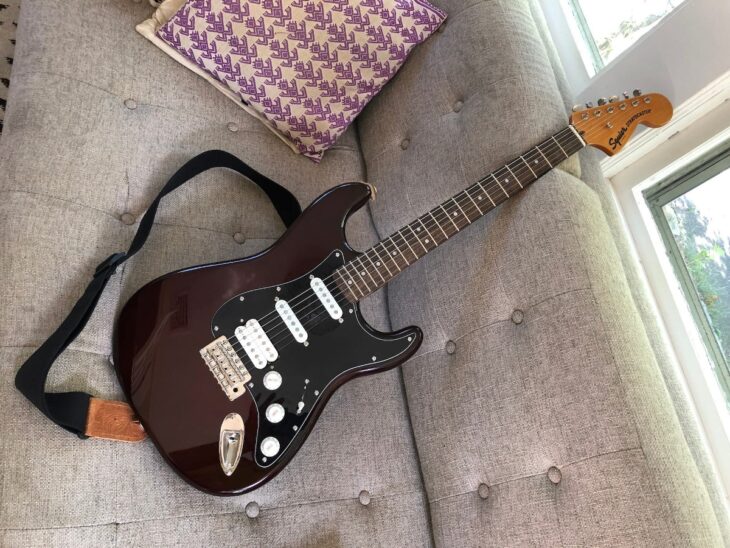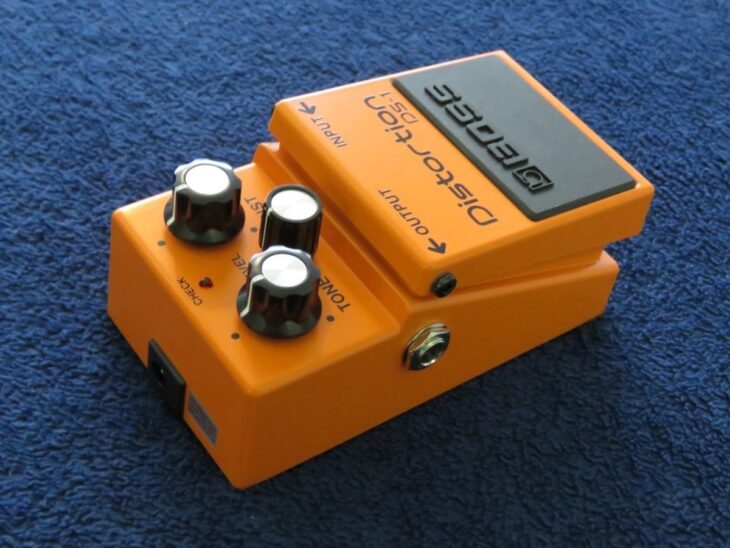Khruangbin means plane in Thai but it is also the name of a Texas trio that has been changing the paradigm of guitar music in the South of the USA for the past decade.
Indeed, with some clever hooks, delightful guitar arrangements, a pool of reverb, and great songs, they went from unknown to stars in record time.
If you’re like me, you’ve already tried nailing that one-of-a-kind tone he goes after. Don’t fall into despair just yet if you can’t recreate it perfectly, Mark’s got a couple of tricks up his sleeve that I’m about to reveal for you.
Table of Contents
Mark Speer Guitar

Mark Speer plays and tours with a single guitar. It’s not a vintage one either, we’re talking about a regular 2001 Fender USA-made ‘70s reissue Stratocaster with a maple neck. Of course, as you’ll see in this article it’s far from being stock, but it’s the canvas for Mark’s unique playing style.
To begin with, Mark swapped out the neck and bridge pickups and put some DiMarzio cruisers which are single-coil-sized humbuckers with dual blades. These changes allowed him to get a slightly darker tone and get rid of the hum.
Although Mark’s exact model has been discontinued, you can get close with a Fender American Vintage II 1973 Stratocaster. I know the price tag is kind of bulky on those, but you can play a Squier Classic Vibe ’70s Stratocaster HSS and you’ll have the humbucker sound in the bridge as well.

Another big change he made to his guitar is the TUSQ saddles. What is TUSQ? Well, it’s a material made with heat and natural polymers and contains no animal by-products at all. These saddles help him avoid the sharp edges that sometimes form on Stratocaster bridges and can cut strings.
Mark’s guitar also has TUSQ string trees and an updated bone nut.
Flatwounds for the Win
Speaking of strings, Mark utilizes a very particular set of strings, he plays flats (or flatwounds). But that’s not all, because he takes a set of 0.10 flats, ditches the low E (0.42), strings his guitar using the A (0.32) string for his low E, and doubles the first 0.10 string.
Out-of-Phase Madness
When wiring his guitar with the new pickups, Mark accidentally wired the middle pickup (the stock Fender pickup) out of phase. Therefore, when he plays anything in that position or combines the neck and middle or bridge and middle, he gets that amazing Peter Green tone you can hear all over their records.
This is one of the essential tricks to get his sound, having an out-of-phase pickup to have that weird, almost dying sound.
Mark Speer Effects Pedals
Mark’s sound comes mostly from his hands, like the tone of most guitarists, but it also comes from his unique use of the guitar’s volume and tone knobs. Yes, I know, tone knobs are the forgotten element available in most guitars that nobody uses. Well, he puts it to use quite a bit.
There’s another big secret to his sound, but more on that in a bit.
Let’s start with the Boss PH-3, a regular, affordable, and easily obtainable phaser pedal. He uses the Rate at noon, Depth at 3 o’clock, Res at noon, and the Stage knob at 8.
Second in line is another Boss pedal, a DS-1.

The particularity is that he uses it with the distortion and tone knobs all the way down and the level all the way up. From the distortion, it goes into the MXR mini–Dyna Comp, another very popular, affordable, and easy-to-find pedal.
He cranks the Output knob and keeps the Sensitivity to a minimum.
From the Dyna Comp, Mark goes into a pedal hidden under psychedelic cloud stickers but it’s another easy-to-get pedal, an Electro-Harmonix Holy Grail reverb pedal. He sets it between noon and one o’clock. The reverb and the compressor always stay ON.

The final pedal on his pedalboard is a much more expensive and complex one, the Strymon El Capistan. He uses it with an expression pedal that handles the repeats so he can leave the pedal droning and play something on top without the need for a looper.
Wait, The Wah Pedal Is ALWAYS ON?
The first pedal on the signal chain is the Wah-Wah pedal. It’s just a regular Dunlop GCB95 Cry Baby but the particularity is that it’s on all the time. Mark finds its sweet spot and leaves it there for the entire show as an integral part of his sound.

Also, the guitarist doesn’t like either the clicking sound of the Wah being turned ON or the sound changing so much when he activates it, so he just leaves it ON all the time and steps on it when he needs to.
Mark Speer Amplifiers
Amplifier-wise, Mark’s approach is the same as he uses with everything else; he relies on a single ’68 Reissue Silver Face Fender Deluxe Reverb. Although that’s the amp you’ll probably catch him using on the road, the tones on the record come from a ’65 Black Face Fender Deluxe Reverb.
If that’s too expensive for your budget, a Hot Rod Deluxe, a Blues Junior, or a Pro Junior will do the job too.

If you wish to play through an amp-less setup, you can also get the UAD Dream 65 pedal.
Mark’s Amp Settings
Mark is a true set-it-and-forget-it kind of player, so he just uses one amp and one setting to get his sound. Since Deluxe Reverbs don’t have a mids control, here are Mark’s settings.
- Volume – 4
- Bass – 9
- Treble – 5
He doesn’t use the Reverb on his amp live but does in the studio. If your amp has a mids control, then just leave it on 5 so it will be neutral.
The Bottom End
Mark Speer is a truly unique guitar player with a Spartan approach toward gear and heavy mileage as a live player. There’s a lot to learn from his setup as well as from his playing. I recommend you give it a try; it will take you to unknown sonic territories.
Who knows? It might be a golden ticket to inspiration and to play more.
Happy (Wah-on) playing!

